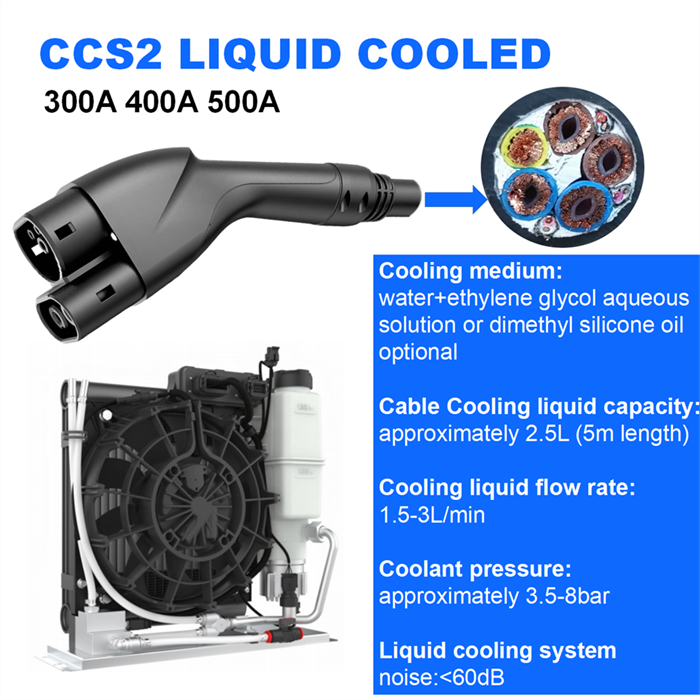Where are liquid-cooled connectors and connectors for liquid cooling used in EVs?
Liquid-cooled connectors are used for carrying high power levels like those found in extreme fast charging (XFC) EV chargers. Connectors for liquid cooling are more common and used for cooling EV battery packs, cooling XFC EV charging stations, and other thermally demanding applications.
This FAQ reviews the performance and use cases for liquid-cooled connectors and connectors for liquid cooling in EVs and look at efforts to combine liquid and vapor cooling for even higher levels of thermal dissipation.
When it can be used, air cooling is the preferred solution. It combines simplicity with low cost. But it’s limited in its ability to dissipate large amounts of heat. Water-based liquid cooling systems can be up to 10 times more effective at dissipating heat. Using other liquids can further increase thermal efficiency. Liquid cooling systems can be prefabricated, sealed designs with liquid inside, and ready for installation. That can simplify initial system fabrication, maintenance, and upgrades.
Faster charging means more heat
Faster charging times are important in the wider adoption of EVs. Transferring more energy to EV batteries involves using higher voltages and higher currents. Increasing the voltage is important but is also limited. Most of the EVs on the road today have battery pack voltages of about 400 V, with 800 to 900 V battery packs representing the leading edge. The goal of XFC is to deliver up to 500 kW of charging power. Even with a 900 V battery pack, that demands lots of current and dissipates lots of heat.
In the US., the EV industry has mostly standardized on the combined charging system (CCS) connector, also called the SAE J1772 combo connector, that can support AC charging or DC fast charging equipment. Without liquid cooling, CCS connectors can support up to about 200 kW of charging power; with the addition of liquid cooling for the contacts, the power rating can be boosted up to 500 kW (500 A at 1 kV).
Liquid cooling also enables the use of smaller, lighter-weight cabling to handle high power levels. Without active cooling, the cables can become too heavy and unwieldy for users to handle.
Liquid cooling is a necessary but not sufficient condition to support 500 kW EV charging efficiently. Active thermal management, including temperature monitoring, is required in high-current EV chargers. Real-time monitoring is needed to ensure the temperature does not exceed the +50°C specification limit (Figure 2). For example, if an overload occurs or the ambient temperature rises unexpectedly (the sun comes out from behind a cloud), the system needs to be able to respond to ensure safe operation quickly. Depending on the circumstances and system design, the response can be to increase the cooling rate or decrease the charging rate to maintain the connector contact temperature rise below the +50°C limit.
How Do Liquid Cooling Rapid Chargers Work?
Liquid cooling rapid chargers use liquid-cooled cables to help combat the high levels of heat associated with high charging speeds. The cooling takes place in the connector itself, sending coolant flowing through the cable and into the contact between the car and the connector. Because the cooling takes place inside the connector, the heat dissipates almost instantly as the coolant travels back and forth between the cooling unit and the connector. Water-based liquid cooling systems can dissipate heat up to 10 times more efficiently, and other liquids can further improve cooling efficiency. Therefore, liquid cooling is receiving more and more attention as the most efficient solution available.
Liquid cooling allows the charging cables to be thinner and lighter, reducing the cable weight by around 40%. This makes them easier for the average consumer to use when charging their vehicle.
Liquid cooling fluid connectors are designed to be durable and withstand external conditions such as high levels of heat, cold, moisture and dust. They’re also designed to withstand massive amounts of pressure to avoid leaks and sustain themselves throughout long charging times.
The liquid cooling process for electric vehicle chargers typically involves a closed-loop system. The charger is equipped with a heat exchanger that is connected to a cooling system, which can be either air-cooled or liquid-cooled. The heat generated during charging is transferred to the heat exchanger, which then transfers it to the coolant. The coolant is typically a mixture of water and a coolant additive, such as glycol or ethylene glycol. The coolant circulates through the charger’s cooling system, absorbing heat and transferring it to a radiator or heat exchanger. The heat is then dissipated into the air or transferred to a liquid cooling system, depending on the design of the charger.
The 500A 600A high-power liquid cooled CCS2 charging system is a dedicated circulation channel set up between the cable and the CCS2 charging connector. Cooling medium is added to the channel, and then the liquid is circulated through the power pump for cooling and heat dissipation.
Fast charging stations need to be efficient. This is more and more important. It’s in the context of the rapid growth of electric vehicles. At its core, this efficiency needs good thermal management. Also, it comes from the increasing need for faster charging. Liquid cooling technology, however, is a key solution to the heat generation inherent in fast charging. This cooling technology speeds up charging. It also ensures the long life and safety of the device. Below, Trumonytechs will show you how our efficient liquid cooling solves the thermal problems of fast charging. It cuts charging time and improves the user experience.
The 600A high-power liquid cooled CCS2 charging system is a dedicated circulation channel set up between the cable and the CCS2 charging connector. 600A 1000V Liquid Cooled CCS2 Cable and Cooling Unit 600A CCS2 Connector 600KW DC Charging Cable with Liquid Cooling for Ultra Fast Charging Cable.
Our CCS2 charging cable 600A is its exceptional charging speed. Capable of delivering up to 600KW of power, this charging cable ensures you can fully charge your electric vehicle’s battery in record time, providing the convenience and peace of mind you need for your daily travels. Whether you’re on a long road trip or just need a quick charge during your busy schedule, the high-speed performance of our charging cables will keep you on the road without unnecessary delays. Say goodbye to long wait times at charging stations and welcome a seamless and efficient charging experience.
Wide Compatibility
In addition to impressive charging speeds, our 600A liquid-cooled CCS2 charging cable comply with the IEC62196-3 charging standard. is widely compatible with most major automotive brands. Whether you drive a Tesla, BMW, Audi, or any other popular electric vehicle model in Europe, you can rely on our charging cables to integrate seamlessly with your vehicle’s charging ports. This versatility ensures you can rely on our products, whether you have an electric vehicle at home or an electric vehicle you encounter on the road. With our charging cables, you enjoy the flexibility and convenience of a universal charging solution tailored to your specific needs.
How does the liquid cooling design of the 600A CCS2 connector contribute to its performance and reliability during high-power charging.The liquid cooling design of the 600A CCS2 connector plays a critical role in enhancing its performance and reliability during high-power charging sessions. By efficiently dissipating heat generated during the charging process, the liquid cooling system helps to maintain optimal operating temperatures within the connector, preventing overheating and ensuring consistent performance.
During high-power charging, the flow of a cooling liquid within the connector absorbs and carries away excess heat, allowing the connector to operate at peak efficiency without experiencing thermal stress. This cooling mechanism not only safeguards the internal components of the connector from damage due to excessive heat but also contributes to its longevity and reliability over extended periods of use.
The liquid cooling design of the 600A CCS2 connector is particularly beneficial in environments where rapid and continuous charging is required, as it helps to regulate temperatures and maintain stable charging conditions. This feature is essential for ensuring the safety of the charging process and protecting both the connector and the electric vehicle from potential risks associated with overheating.How does the liquid cooling design of the 600A CCS2 connector contribute to its performance and reliability during high-power charging?
The liquid cooling design of the 600A CCS2 connector plays a critical role in enhancing its performance and reliability during high-power charging sessions. By efficiently dissipating heat generated during the charging process, the liquid cooling system helps to maintain optimal operating temperatures within the connector, preventing overheating and ensuring consistent performance.
During high-power charging, the flow of a cooling liquid within the connector absorbs and carries away excess heat, allowing the connector to operate at peak efficiency without experiencing thermal stress. This cooling mechanism not only safeguards the internal components of the connector from damage due to excessive heat but also contributes to its longevity and reliability over extended periods of use.
The liquid cooling design of the 600A CCS2 connector is particularly beneficial in environments where rapid and continuous charging is required, as it helps to regulate temperatures and maintain stable charging conditions. This feature is essential
Post time: Jan-02-2025

 Portable EV Charger
Portable EV Charger Home EV Wallbox
Home EV Wallbox DC Charger Station
DC Charger Station EV Charging Module
EV Charging Module NACS&CCS1&CCS2
NACS&CCS1&CCS2 EV Accessories
EV Accessories



